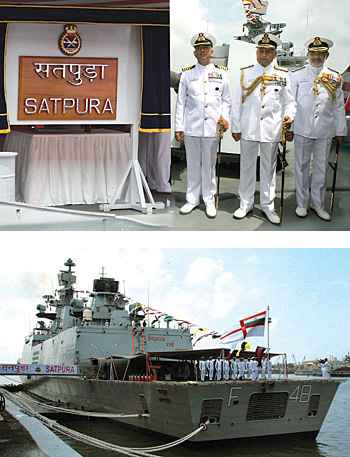INDIAN ARMED FORCES CHIEFS ON
OUR RELENTLESS AND FOCUSED PUBLISHING EFFORTS

SP Guide Publications puts forth a well compiled articulation of issues, pursuits and accomplishments of the Indian Army, over the years

I am confident that SP Guide Publications would continue to inform, inspire and influence.

My compliments to SP Guide Publications for informative and credible reportage on contemporary aerospace issues over the past six decades.
INS Satpura
Indigenously Designed Warship

Chief of the Naval staff, Admiral Nirmal Verma commissioned Satpura, the second stealth frigate of the Shivalik class, into the Indian Navy
Indian Naval Ship (INS) Satpura, the second indigenously designed and constructed stealth frigate of the Shivalik class, built by Mazagon Dock Limited (MDL), Mumbai, was commissioned into the Indian Navy by the Chief of the Naval Staff, Admiral Nirmal Verma on August 20.
The ceremony was marked with a Guard of Honour. The Chairman and Managing Director (CMD), MDL, Vice Admiral (Retd) H.S. Malhi addressed the gathering which was followed by the Commanding Officer Captain Sharath Mohan reading out the commissioning warrant. The National Flag and Naval Ensign were hoisted along with the commissioning pennant on-board the ship.
Satpura is armed with a formidable array of surface, sub-surface and air defence weapons. These include long-range anti-ship missiles, anti-aircraft missiles and anti-missile defence systems, which can detect and engage the enemy at extended ranges, thereby giving it significant combat power. The weapon-sensor fit of Satpura is controlled through a combat management system, designed and developed by the Indian Navy and manufactured by Bharat Electronics. The system allows the seamless integration of the ship’s systems as well as with the weapons and sensors of other fleet ships, thus enabling the concept of ‘cooperative engagement capability’. The ship carries two multirole helicopters to provide enhanced surveillance and attack capability.
This class of ships will be the mainstay frigates of the Indian Navy in the first half of the 21st century. The incorporation of new design features on-board effectively reduces the probability of it being detected at sea. The in-built, structural, thermal and acoustic stealth features augment the potent capability of the ship to address threats in all dimensions of maritime warfare.
The ship is propelled by two modern LM 2500 gas turbine, which enable it to generate speeds in excess of 30 knots (55 kmph), and two SEMT Pielstic diesel engines for normal cruising speeds. The ship’s electric power is provided by four diesel alternators, which together produce four megawatts of power, enough to light up a small town. The power generation and distribution on-board is controlled through an ‘automated power management system’.
The ship is also equipped to operate in an environment contaminated by nuclear, biological or chemical agents. The state-ofthe-art total atmospheric control system ensures filtration of the air going into the ship at all times. In addition, it ensures the complete removal of radioactive, chemical or biological impurities, thereby protecting the crew and ship-borne systems.
The accommodation for 35 officers and 250 crew members of the ship incorporates advanced ergonomic design and ensures crew comfort and space management.





